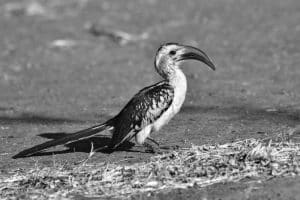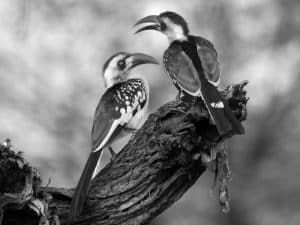Introduction to the Tanzanian Red-Billed Hornbill
Welcome to the world of the Tanzanian Red-Billed Hornbill, a captivating bird species that graces the Tanzanian skies with its vibrant plumage and distinctive call. This remarkable avian creature, scientifically known as Tockus ruahae, is a member of the hornbill family and is revered for its striking appearance and unique behaviors. Found exclusively in the wilds of Tanzania, the Tanzanian Red-Billed Hornbill holds a special place in the hearts of both locals and wildlife enthusiasts from around the globe.

The Tanzanian Red-Billed Hornbill is widely distributed across various regions of Tanzania, including the iconic Serengeti National Park, the verdant forests of the Udzungwa Mountains, and the sweeping plains of the Selous Game Reserve. These diverse habitats provide the perfect backdrop for observing the hornbill in its natural environment, allowing visitors to witness its captivating flight patterns and intriguing social interactions. As we delve deeper into the world of this magnificent bird, you will gain a deeper understanding of its significance within the Tanzanian ecosystem and the efforts being made to ensure its continued survival.
Habitat and Distribution of the Tanzanian Red-Billed Hornbill in Tanzania
The Tanzanian Red-Billed Hornbill is predominantly found in the woodlands, savannas, and open forests of Tanzania, where it thrives in the presence of mature trees and ample foraging opportunities. These habitats provide the hornbill with an abundant supply of fruits, insects, and small reptiles, which form the cornerstone of its diet. The bird’s distribution spans across both protected areas and non-protected landscapes, highlighting its adaptability to varying environmental conditions.
In the northern regions of Tanzania, such as the Tarangire National Park and Lake Manyara, the hornbill is a common sight, often spotted perched on tree branches or gliding gracefully through the air. As we venture into the southern reaches of the country, the Selous Game Reserve emerges as another key stronghold for the species, showcasing the diverse range of ecosystems that the Tanzanian Red-Billed Hornbill calls home. By understanding the intricate relationship between the bird and its habitat, we can appreciate the delicate balance that sustains this emblematic species.
Unique Characteristics of the Tanzanian Red-Billed Hornbill
The Tanzanian Red-Billed Hornbill is distinguished by its vibrant plumage, with striking red and black markings adorning its sleek body. Its most notable feature is the vivid red bill, which contrasts sharply against the deep ebony feathers, creating a visual spectacle that captures the imagination. Additionally, the hornbill possesses a prominent casque atop its bill, a feature that sets it apart from other avian species and adds to its charismatic allure.
In terms of behavior, the hornbill is known for its distinctive call, a melodic sound that resonates through the treetops and serves as a means of communication within its social groups. This vocalization, combined with its agile flight and agile movements, contributes to the bird’s charismatic presence in the wild. As we delve deeper into the unique characteristics of the Tanzanian Red-Billed Hornbill, we gain a deeper appreciation for the intricate details that make this species a true symbol of Tanzania’s natural heritage.
Behavioral Patterns and Mating Habits
The behavioral patterns of the Tanzanian Red-Billed Hornbill provide valuable insights into its social structure and mating rituals. The hornbill is often observed in pairs or small family groups, where cooperative breeding and communal nesting are integral aspects of its social dynamics. During the breeding season, the male hornbill engages in elaborate courtship displays, showcasing its vibrant plumage and engaging in acrobatic flights to attract a potential mate.
Once a pair bond is established, the female hornbill seeks out a suitable nesting cavity within a tree, where she seals herself inside using a mixture of mud, droppings, and food remains. This remarkable behavior, known as “walling in,” serves to protect the nesting female and her offspring from potential predators, highlighting the intricate adaptations that have evolved within the species. By delving into the mating habits and behavioral patterns of the Tanzanian Red-Billed Hornbill, we gain a deeper understanding of the complex relationships that underpin its existence.
Conservation Efforts for the Tanzanian Red-Billed Hornbill

Conservation efforts aimed at safeguarding the Tanzanian Red-Billed Hornbill are crucial for ensuring the long-term viability of the species. Organizations such as the Tanzania Wildlife Research Institute (TAWIRI) and the Tanzania Forest Conservation Group (TFCG) have spearheaded initiatives focused on monitoring hornbill populations, conducting research on their habitat requirements, and raising awareness about the threats facing the species.
One of the primary conservation challenges for the Tanzanian Red-Billed Hornbill is the loss of its natural habitat due to deforestation, agricultural expansion, and human encroachment. By promoting sustainable land management practices and advocating for the protection of key hornbill habitats, conservationists are working towards securing a brighter future for the species. Furthermore, community-based conservation programs that involve local stakeholders are instrumental in fostering a sense of coexistence between human communities and the hornbill’s natural environment.
The Role of the Tanzanian Red-Billed Hornbill in Tanzanian Ecosystems
The Tanzanian Red-Billed Hornbill plays a vital role in maintaining the ecological balance of Tanzania’s diverse ecosystems. As a frugivorous bird, it contributes to seed dispersal by consuming a variety of fruits and then dispersing the undigested seeds across different locations. This process aids in the regeneration of plant species and supports the overall health of forest and woodland habitats.
Furthermore, the hornbill’s foraging behavior, particularly its consumption of insects and small reptiles, helps control insect populations and contributes to the ecological equilibrium within its habitat. By understanding the multifaceted role of the Tanzanian Red-Billed Hornbill in Tanzanian ecosystems, we can appreciate the interconnectedness of all living organisms and the delicate web of life that sustains the natural world.
Cultural Significance and Folklore Surrounding the Tanzanian Red-Billed Hornbill
The Tanzanian Red-Billed Hornbill holds a prominent place in the cultural heritage and folklore of Tanzania, where it is revered as a symbol of resilience, adaptability, and natural beauty. Across various indigenous communities, the hornbill is depicted in traditional art, storytelling, and ceremonial practices, reflecting its deep-rooted significance in local beliefs and customs. Its vibrant plumage and striking appearance have inspired artistic expressions and cultural narratives that celebrate the intrinsic connection between humans and the natural world.
In Maasai folklore, the hornbill is often associated with wisdom and foresight, embodying the spirit of vigilance and adaptability in the face of adversity. This symbolic representation underscores the profound impact of the hornbill on the cultural identity of Tanzanian communities, emphasizing the need to preserve and protect its existence for future generations. By exploring the cultural significance and folklore surrounding the Tanzanian Red-Billed Hornbill, we gain a deeper appreciation for the timeless bond between humans and the natural world.
Challenges Facing the Tanzanian Red-Billed Hornbill
Despite its cultural significance and ecological importance, the Tanzanian Red-Billed Hornbill faces a myriad of challenges that threaten its survival. Habitat destruction, driven by deforestation and land conversion for agricultural purposes, remains a pressing issue that diminishes the availability of suitable nesting sites and foraging grounds for the hornbill. Additionally, the illegal pet trade poses a significant threat to the species, leading to the capture and exploitation of wild hornbills for commercial gain.
Climate change further exacerbates the vulnerability of the hornbill, impacting the availability of food resources and altering the environmental conditions within its habitat. These compounding factors underscore the urgent need for concerted conservation efforts and sustainable management practices to mitigate the threats facing the Tanzanian Red-Billed Hornbill. By acknowledging the challenges confronting the species, we can take proactive steps towards safeguarding its future.
Ways to Support the Conservation of the Tanzanian Red-Billed Hornbill

As advocates for the preservation of Tanzania’s natural heritage, there are several meaningful ways to contribute to the conservation of the Tanzanian Red-Billed Hornbill. Supporting local conservation organizations and wildlife reserves that prioritize the protection of hornbill habitats is an effective means of making a tangible difference. By volunteering your time, expertise, or financial resources, you can directly support conservation initiatives that focus on monitoring hornbill populations, conducting research, and implementing habitat restoration projects.
Raising awareness about the plight of the Tanzanian Red-Billed Hornbill within your community and advocating for sustainable environmental practices can also have a significant impact. By fostering a culture of environmental stewardship and promoting responsible tourism, individuals can contribute to the broader efforts aimed at preserving the hornbill’s natural habitat. Additionally, engaging in ecotourism experiences that prioritize ethical wildlife encounters and promote conservation education can further bolster the conservation of the species.
Conclusion
In conclusion, the Tanzanian Red-Billed Hornbill stands as a vibrant symbol of Tanzania’s rich biodiversity and cultural heritage. From its captivating plumage and unique behaviors to its essential role in maintaining ecological balance, the hornbill embodies the interconnectedness of all living organisms within the natural world. By recognizing the significance of the hornbill and actively supporting its conservation, we can ensure that future generations continue to marvel at the sight of these scarlet beacons gracing the Tanzanian skies. Let us join hands in preserving the legacy of the Tanzanian Red-Billed Hornbill and safeguarding the irreplaceable wonders of Tanzania’s natural landscapes.
































